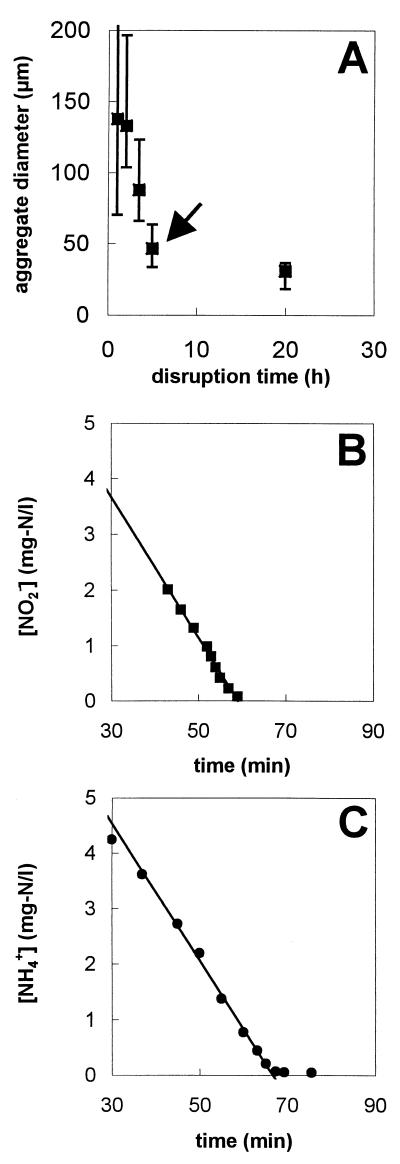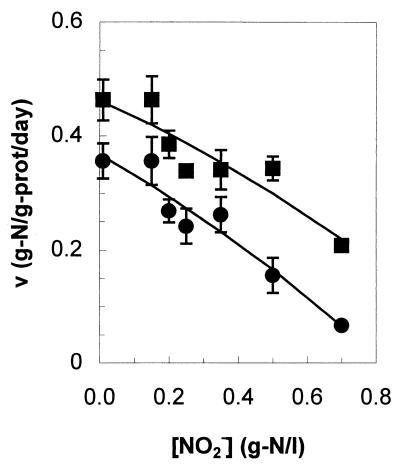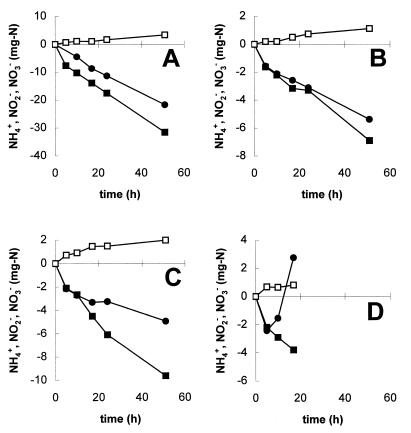Abstract
The physiology of anaerobic ammonium oxidizing (anammox) aggregates grown in a sequencing batch reactor was investigated quantitatively. The physiological pH and temperature ranges were 6.7 to 8.3 and 20 to 43°C, respectively. The affinity constants for the substrates ammonium and nitrite were each less than 0.1 mg of nitrogen per liter. The anammox process was completely inhibited by nitrite concentrations higher than 0.1 g of nitrogen per liter. Addition of trace amounts of either of the anammox intermediates (1.4 mg of nitrogen per liter of hydrazine or 0.7 mg of nitrogen per liter of hydroxylamine) restored activity completely.
Anaerobic ammonium oxidation (anammox) is the biological conversion of ammonium and nitrite to dinitrogen gas. It is an almost completely unexplored part of the biological nitrogen cycle, and the process offers new opportunities for wastewater engineers and microbiologists (2). Previously, a morphologically unusual microorganism was enriched while the anammox activity increased (6), and a novel metabolic pathway was postulated (5). This pathway proceeded via hydroxylamine and hydrazine. In the present study, we have investigated the physiology of aggregated anammox biomass (80% enriched in the morphotypical microorganism) grown in a sequencing batch reactor (4). The compilation of this physiological information is the key to the future design and scale-up of the anammox process and will greatly facilitate microbiological investigation of the responsible microorganism(s).
Physiological temperature and pH ranges.
The maximum specific-substrate (ammonium and nitrite) conversion rate of aggregated anammox biomass was measured as a function of temperature and pH in batch experiments, in the absence of mass transfer limitations (see Table 1). From the temperature dependency of anammox activity, the activation energy was calculated to be 70 kJ/mol, approximately the same as for aerobic ammonium oxidation (7).
TABLE 1.
Important physiological parameters for anaerobic and aerobic ammonium oxidation
| Parameter | Anammox result | Nitrificationa result | Unit |
|---|---|---|---|
| Maximum specific aerobic NH4+ consumption rate | 0 | 2–5 | g of NH4+-N · g of protein−1 day−1 |
| Maximum specific anaerobic NH4+ consumption rate | 1.1 | <0.05b | g of NH4+-N · g of protein−1 day−1 |
| Biomass yield | 0.07 | 0.1 | g of protein · g of NH4+-N−1 |
| Activation energy | 70 | 70 | kJ · mol−1 |
| Affinity for ammonium | ≤10−4 | ≥10−4 | g of NH4+-N · liter−1 |
| Affinity for nitrite | ≤10−4 | NAc | g of NO2−-N · liter−1 |
| Nitrite inhibition of ammonium consumption | Ki = 0.8, α = 0.8 | Usually | g of NO2−-N · liter−1 |
| Nitrite inhibition of nitrite consumption | Ki = 1, α = 0.7 | NA | g of NO2−-N · liter−1 |
| Temp range | 20–43 | ≤42°C | °C |
| pH range | 6.7–8.3 | Variable | |
| Protein content of biomass | 0.6 | Variable | g of protein · g total dry weight−1 |
| Protein density | 50 | Variable | g of protein · liter biomass−1 |
Affinity.
Before the substrate affinities were measured, the biomass aggregates were partially disrupted (by intense magnetic stirring), to reduce mass transfer limitation at low substrate concentrations. Figure 1A shows the aggregate size distribution during aggregate disruption. The affinity was measured after 5 h, when 80% of the aggregates had diameters less than 50 μm. Figures 1B and C show that the substrate decreases during the experiment were linear down to 0.15 mg of nitrogen per liter for ammonium and 0.05 mg of nitrogen per liter (the detection limit) for nitrite. Beyond these low substrate concentrations, the deviation from zero-order kinetics could have been caused by the approach of the affinity constant or by mass transfer limitation. Therefore, we concluded that the anammox affinity constants for ammonium and nitrite were equal to or less than 0.1 mg of nitrogen per liter (Table 1).
FIG. 1.
Determination of the substrate affinity of the anammox process. Decrease of the aggregate size during the aggregate disruption period (A). Nitrite (B) and ammonium (C) concentrations plotted against time, measured after a 5-h aggregate disruption period (arrow in A). Error bars represent standard deviations.
Inhibition.
The anammox process was not inhibited by ammonium or by the by-product nitrate up to concentrations of at least 1 g of nitrogen per liter. However, in the presence of more than 0.1 g of nitrite nitrogen per liter, the process was completely inhibited. This nitrite inhibition could be overcome by addition of trace amounts of either of the anammox intermediates (>1.4 mg of nitrogen per liter for hydrazine, >0.7 mg of nitrogen per liter for hydroxylamine). After a hydrazine pulse of 3 mg of nitrogen per liter of N2H4 was used to start the anammox reaction, the resulting anammox activity was measured between pH 7 and 7.8 at different nitrite concentrations. It appeared that the anammox activity decreased with increasing nitrite concentration. This decrease was independent of pH at the pH range tested (7 to 7.8). Anammox activity is plotted against nitrite concentration in Fig. 2 (12 different batch experiments at 6 different substrate concentrations at pH 7, 7.4, and 7.8).
FIG. 2.
Immediate inhibition of the anammox process by nitrite. Specific ammonium (●) and nitrite (■) consumption rates. Lines indicate the fit of the Luong model to the data. Error bars represent standard deviations. Prot, protein.
Figure 2 also shows that with increasing nitrite concentration the stoichiometry of ammonium and nitrite consumption changed from 1.3 g of NO2−-N/g NH4+-N at 0.14 g of nitrogen per liter to almost 4 g of NO2−-N/g NH4+-N at 0.7 g of nitrogen per liter. From the distorted stoichiometry at high nitrite concentrations, it was clear that the microorganisms under these conditions did not only use ammonium as the electron donor but also must have generated an internal electron donor to reduce the nitrite.
Three different substrate inhibition models (Edwards, Andrews, and Luong models) were fitted to the data (3). For each model, the parameters that gave the least residual sum of squares were calculated, and R2 was calculated for the linearized models as an estimate of the validity of the obtained curves. The calculated sums of squares were used to compare the models in an F test (1).
The Luong model fitted the experimental data best (R values were NH4+ = 0.92 and NO2− = 0.84). The coefficients were Ki = 0.8 g of nitrogen per liter and α = 0.8 for inhibition of ammonium oxidation by nitrite, and Ki = 1 g of nitrogen per liter and α = 0.7 for inhibition of nitrite reduction by nitrite. The F test showed that, with 73 and 85% respective certainty, the Luong model was better than the Edwards and Andrews models.
The hydrazine or hydroxylamine added at the start of each experiment was consumed very rapidly (within 10 min), but the durations of these experiments were much longer (up to 4 h). Apparently, the biomass only needed the N2H4 or NH2OH pulse to get started. Still, it made sense to investigate how long the biomass would be able to remain active in the presence of high nitrite concentrations, after the N2H4 had disappeared.
Prolonged exposure to nitrite.
Nitrite inhibition over a 50-h period was investigated in fed-batch experiments conducted under ammonium limitation with different resultant nitrite concentrations (0.06, 0.09, and 0.2 g of nitrogen per liter). In Fig. 3, the results are compared with a control experiment under nitrite limitation. In the control experiment and at 0.06 g of nitrite nitrogen per liter (Fig. 3A and B), ammonium and nitrite consumption and nitrate production remained constant over the course of the experiment, and the stoichiometry was as expected.
FIG. 3.
Consumption of ammonium (●) and nitrite (■) (shown as negative values), and production of nitrate (□) by the anammox process in 50-h fed-batch experiments. (A) Nitrite concentration = 0; (B) nitrite concentration = 0.06 g of nitrogen per liter; (C) nitrite concentration = 0.09 g of nitrogen per liter; (D) nitrite concentration = 0.2 g of nitrogen per liter (ammonium production after 10 h).
At 0.09 g of nitrite nitrogen per liter, the stoichiometry changed during the course of the experiment (Fig. 3C), much like the stoichiometric change illustrated in Fig. 2. The ratio of nitrite consumption to ammonium consumption increased to 2. At 0.2 g of nitrite nitrogen per liter, the anammox process proceeded normally only for the first 4 h of the experiment (Fig. 3D). After 4 h, the stoichiometry changed like in the previous experiments, but more strongly. Within 20 h, ammonium was produced in this experiment. Note that in Fig. 2 the inhibition of the anammox process was not yet apparent at 0.2 g of nitrite nitrogen per liter. After 20 h, two aliquots from the biomass described in Fig. 3D were reincubated in two different batch experiments with 0.26 g of nitrogen per liter of ammonium and nitrite. To one of these batches, hydrazine was added to a final concentration of 3 mg of nitrogen per liter. In this batch, the anammox activity was completely recovered, as shown by rapid conversion of ammonium and nitrite and nitrate production with normal stoichiometry. In the control experiment without hydrazine addition, the activity was not restored—no ammonium and no nitrite were converted. Apparently, the anammox process is strongly stimulated by its intermediates.
The physiological parameters of anaerobic ammonium oxidation are compiled in Table 1. This table also shows the parameters for aerobic nitrifiers, because these organisms resemble anammox from a physiological point of view. Both organisms are specialists: anammox has no aerobic activity, and the anaerobic activity of aerobic nitrifiers is only 5% that of the anammox activity. However, biomass yield, temperature range, substrate affinity, and activation energy are approximately the same for these anaerobic and aerobic organisms. Only the maximum specific-substrate conversion is much lower for anammox. Combined with the slightly lower biomass yield, this leads to the dramatic doubling time of 9 days under optimal conditions.
Acknowledgments
This research was financially supported by the Foundation for Applied Sciences (STW), the Royal Netherlands Academy of Arts and Sciences (KNAW), and the Gist-brocades and DSM companies.
We gratefully acknowledge Katinka van de Pas-Schoonen and Anke de Bruyn for careful maintenance of bench scale and pilot reactors, Mark van Loosdrecht for critical reading of the manuscript, and Sebastiaan Peeters for assistance with inhibition experiments.
REFERENCES
- 1.Elmen J, Pan W, Leung S Y, Magyarosy A, Keasling J D. Kinetics of toluene degradation by a nitrate-reducing bacterium isolated from a groundwater aquifer. Biotechnol Bioeng. 1997;55:82–90. doi: 10.1002/(SICI)1097-0290(19970705)55:1<82::AID-BIT10>3.0.CO;2-5. [DOI] [PubMed] [Google Scholar]
- 2.Jetten M S M, Strous M, van de Pas-Schoonen K T, Schalk J, van Dongen L, van de Graaf A A, Logemann S, Muyzer G, van Loosdrecht M C M, Kuenen J G. The anaerobic oxidation of ammonium. FEMS Microbiol Rev. 1998;22:421–437. doi: 10.1111/j.1574-6976.1998.tb00379.x. [DOI] [PubMed] [Google Scholar]
- 3.Luong J H T. Generalization of Monod kinetics for analysis of growth data with substrate inhibition. Biotechnol Bioeng. 1987;29:242–248. doi: 10.1002/bit.260290215. [DOI] [PubMed] [Google Scholar]
- 4.Strous M, Heijnen J J, Kuenen J G, Jetten M S M. The sequencing batch reactor as a powerful tool for the study of slowly growing anaerobic ammonium-oxidizing microorganisms. Appl Microbiol Biotechnol. 1998;50:589–596. [Google Scholar]
- 5.Van de Graaf A A, de Bruin P, Robertson L A, Jetten M S M, Kuenen J G. Metabolic pathway of anaerobic ammonium oxidation on basis of 15N-studies in a fluidized bed reactor. Microbiology (UK) 1997;143:2415–2421. doi: 10.1099/00221287-143-7-2415. [DOI] [PubMed] [Google Scholar]
- 6.Van de Graaf A A, de Bruijn P, Robertson L A, Jetten M S M, Kuenen J G. Autotrophic growth of anaerobic ammonium-oxidizing micro-organisms in a fluidized bed reactor. Microbiology (UK) 1996;142:2187–2196. [Google Scholar]
- 7.Wiesman U. Biological nitrogen removal from wastewater. Adv Biochem Eng Biotechnol. 1997;51:113–153. doi: 10.1007/BFb0008736. [DOI] [PubMed] [Google Scholar]
- 8.Zart D, Bock E. High rate of aerobic nitrification and denitrification by Nitrosomonas eutropha grown in a fermentor with complete biomass retention in the presence of gaseous NO2 or NO. Arch Microbiol. 1998;169:282–286. doi: 10.1007/s002030050573. [DOI] [PubMed] [Google Scholar]





